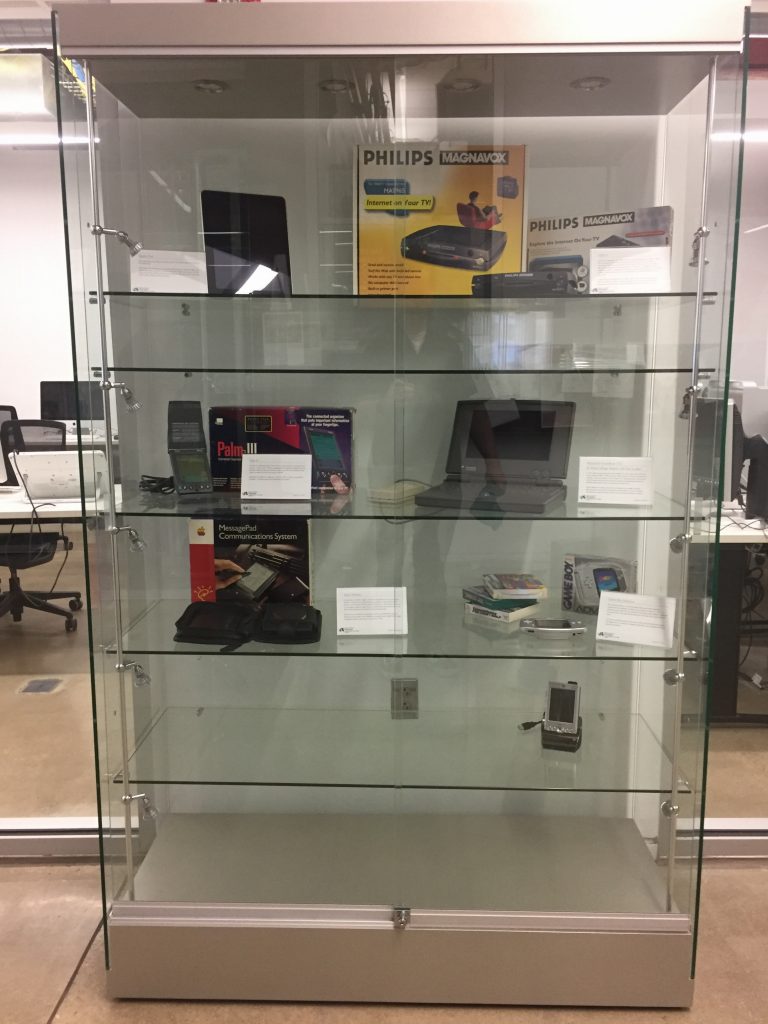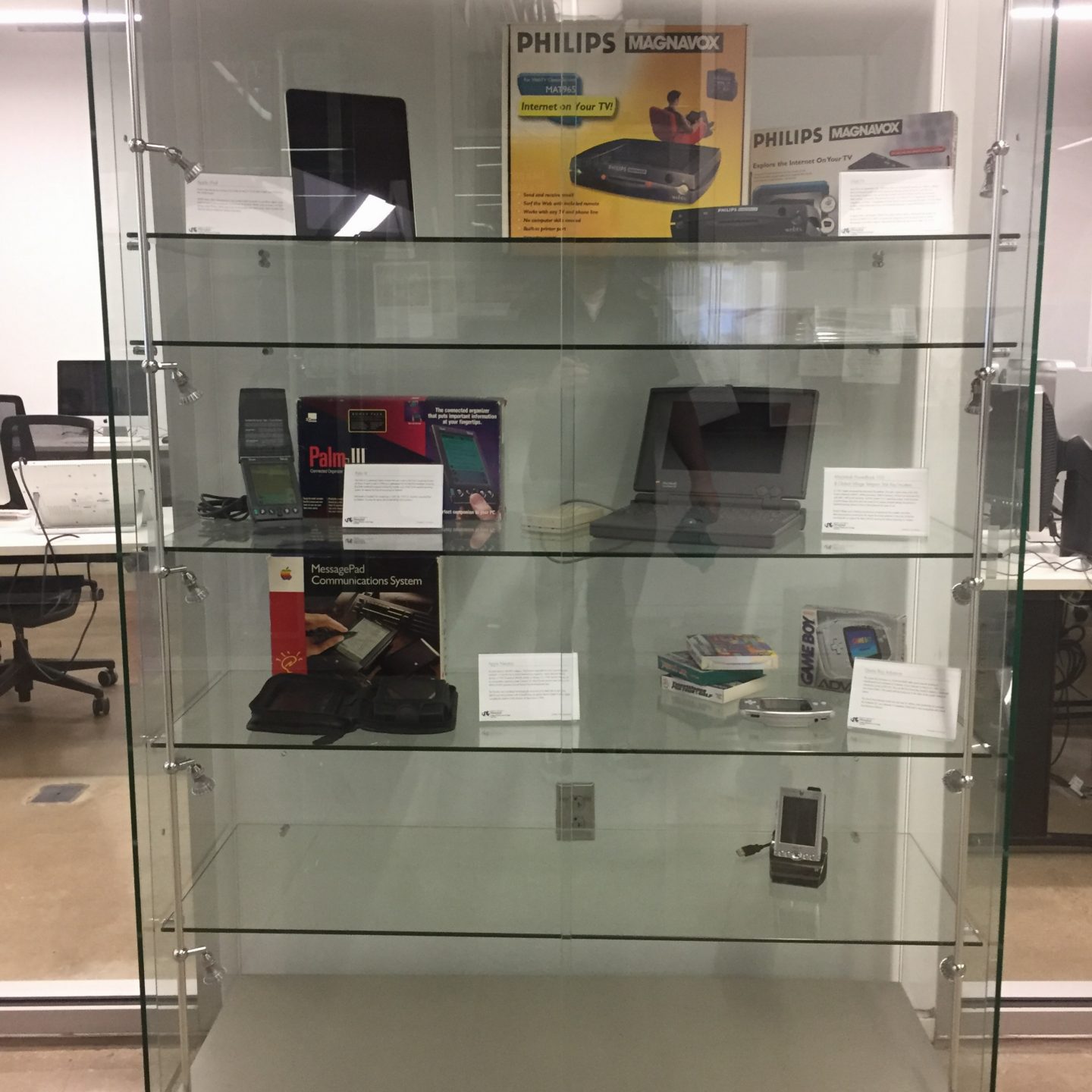We recently installed a display case in our hallways to feature historic interactive technologies, this coincides with our IDM-101 History of Web Development class where we discuss historic modes of connecting and designing for the web.

Currently on Display:
- HTC Dream
- On October 2008, Google introduces Android 1.0 as featured on the HTC Dream. This Linux-based operating system was developed by Google and the Open Handset Alliance to create an open competitor to other major smartphone platforms. The Dream was released to mixed, but mostly positive reception. While the Dream was praised for its solid and robust hardware design, the introduction of the Android operating system was met with criticism for its lack of certain functionality and third-party software in comparison to more established platforms, but was still considered to be innovative due to its open nature, notifications system, and heavy integration with Google’s services.
- Apple iPad (Gen 1)
- Apple released the first version of it’s iPad on April 3 2010 with a retail cost of $629 for the 16GB model. While many other manufacturers had created tablet computers long before Apple, none had reached market penetration to the level of the iPad. While some accused it of “just” being a big iPhone, others say it was the first tablet that made sense. Many experts claim that this device redefined mobile computing.
- WebTV
- Launched on September 18, 1996 by Diba, Inc and Zenith Electronics, WebTV offered television-based e-mail and Web browsing. Initially priced at $329, and $50 for the wireless keyboard. The service fee initially was $19.95 per month for unlimited Web surfing and e-mail. The set-top box had 112 MHz CPU, 2 megabytes of RAM, 2 megabytes of ROM, 1 megabyte of Flash memory and connected through a 33.6k dialup modem. Initial sales were slow, but eventually peaked at about 800,000 subscribers in May 1999. In April 1997, MS bought WebTV for $425 million dollars. Microsoft rebranded the service as MSN TV in 2001 to accelerate integration with products such as MSN Messenger and MSN Hotmail. Microsoft shut down the service on Sept. 30, 2013.
- Palm III
- The Palm III is a personal digital assistant that was made by the Palm Computing division of 3Com. It went on sale in 1998 as a replacement for the PalmPilot handheld. It was the first Palm handheld to support infrared file transfer and a Flash ROM-capable operating system. At release, the Palm III was priced at US$400. Jeff Hawkins founded Palm computing in 1992. By 1995 U.S. Robotics acquired Palm for $44mil. This was the device that kicked off the PDA revolution.
- Macintosh PowerBook 100 & Global Village Teleport 56k fax/modem
- In 1991 Apple introduced the Macintosh PowerBook 100 with a retail value of $2,300. It had a Motorola 68000 16MHz processor, 2MB of memory, a 9-inch monochrome LCD with 640 × 400 pixel resolution, and the System 7.0.1 operating system. It did not have a built-in floppy disk drive and was noted for its unique compact design that placed a trackball pointing device in front of the keyboard for ease of use.
Global Village was a leading manufacturer of easy-to-use fax modems and other telecommunications products for the Apple Macintosh platform. It was one of the few manufacturers to support the Mac’s RS422 serial ports without requiring an adaptor. - Apple Newton
- An early device in the PDA category – the Newton originated the term “personal digital assistant” – it was the first to feature handwriting recognition. Apple sshipped the first devices in 1993. Production officially ended on February 27, 1998. Newton devices run on a proprietary operating system, Newton OS. Most Newton devices were based on the ARM 610 RISC processor and all featured handwriting-based input.
- Game Boy Advance
- The Game Boy Advance is a 32-bit handheld video game console developed, manufactured and marketed by Nintendo. It was released on March 21, 2001 at an introductory proce of $19.99. This was the first Game Boy model to feature a landscape form factor (240 x 160 pixels) with the buttons on to the sides of the screen instead of below.
- Dell Axim Pocket PC
- Launched in 2002, the Dell Axim was a Pocket PC device (powered by Windows CE) that enablesd users to store and retrieve e-mail, contacts, appointments, tasks, play multimedia files, games, exchange text messages with Windows Live Messenger, browse the Web, and more.
Wish List:
If you have any of the following and would be interested in donating it to the department please contact troy.finamore@drexel.edu
- Apple HyperCard Manuals
- Amazon Fire Phone
- Blackberry 6210
- Blackberry Z10
- Fossil Wrist PDA
- Handspring Trio 180
- HTC Surround
- iPhone (Gen 1)
- Microsoft Band
- Moto 360
- Motorola RAZR
- Palm Pilot 1000
- Palm Pre
- Pebble
- Rim 950
- Samsung Galaxy Tab (2010 – 1st Edition Android Tablet)
- Samsung Series 5 (1st Chromebook)
- Sony Smartwatch 1
- Symbian OS (Nokia N95, E71, 3650, 808, E90, E7)
- US Robotics Sportster 28k Fax Modem

